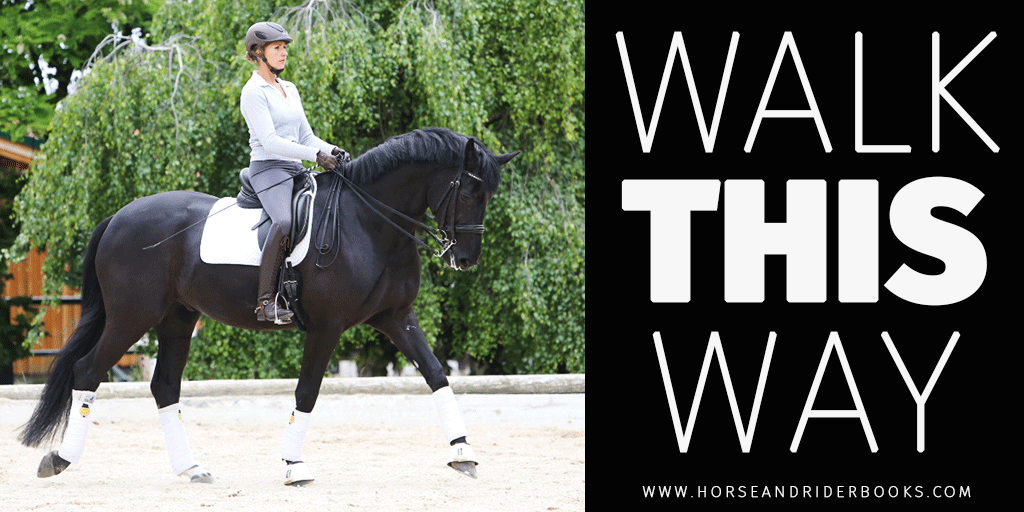Arthur Kottas-Heldenberg was accepted as a student at the Spanish Riding School of Vienna in 1960 and rose rapidly under the tutelage of Colonel Alois Podhajsky to become the youngest ever First Chief Rider in the history of the school. Internationally respected, Kottas has successfully trained many horses and riders to Olympic standard in dressage. Here he provides easy-to-try solutions for three of the most common problems found with the horse’s walk.
Problem 1: Breaks Rhythm (Pacing)
Common cause: Tension in the back.
Solutions
- Using poles or low cavalletti can encourage freer steps and regularize the rhythm. An average distance between poles for walk work is 0.9m, but be prepared to alter this to suit the horse’s stride length.
- The rider needs to be able to feel what is going on in his horse, otherwise the timing of the aids depends on luck, and this can affect the clarity of the gait. If the rider does have difficulty feeling the movement, he can practice calling out the leg sequence. Riding without stirrups and with a deep seat will help the rider to feel the horse’s motion and leg sequence clearly.
- Riding up and down hills is useful. A forward stride downhill normally improves the walk to four clear beats.
- Ride transitions from free walk to medium and to free walk again. This will encourage relaxation of the horse’s back muscles. (Note the rider must take care to retake the rein contact carefully, so as to keep the relaxed quality in the medium walk. Taking a strong hold will create tension that will affect the walk rhythm.
- Riding a walk shoulder-in is a good way to clear the pace to a correct four-beat rhythm.
- If the gait is very hurried, this can cause the walk to become lateral. Try slowing the walk right down until the walk becomes four-beat again.

Problem 2: Walk Too Fast (Breaks into Jog)
Common cause: A nervous or excitable horse.
Solutions
- Be very patient and spend long periods in walk on a long rein to relax the horse.
- The rider must sit very still and quietly, so that eventually the horse tunes into the rider’s calm state and begins to relax, too.
- Some horses become tense when they feel the rider’s legs on their sides. Keep your legs very light, so that he will gradually accept them without becoming tense.
- Some young or cold-backed horses benefit from being longed before ridden work. This gives them time to relax without the disturbance of the rider’s weight on their back.
- Use half-halts and frequent transitions to a square halt and walk again to gradually settle the walk.
Problem 3: Lazy Walk
Common cause: Dullness to the aids; poor rider position or aiding.
Solutions
- Try giving alternate leg aids, coordinated with each hind leg stepping forward. You should feel the moment through your seat bones. Apply the leg just before the hind foot on the same side leaves the ground.
- It is important that the rider is not tense or stiff in his back, or it will inhibit the horse’s freedom to walk forwards freely.
- Strong rein contact can have the same effect. Try making small forward yields in the reins and keeping the wrists relaxed, to remove the “handbrake.”
- Legs that constantly kick or grip tightly will dull the horse and make the walk feel lazy. The rider should keep a light touch with his legs on the horse’s sides and use the aids sparingly, supported by a touch from the whip if necessary. When the horse responds, the rider must cease the aid and sit quietly with relaxed legs that “drape” around the horse’s sides.
- Riding over ground poles can improve the activity of the walk. Once the horse is negotiating them calmly, the distance between them can be slightly lengthened to encourage a longer stride. Pole work or low cavalletti can introduce some variety into the schooling and many horses enjoy this and we can therefore achieve improvements and give the horse some fun in his work.
- Making frequent transitions up and down will help bring the horse onto your aids more attentively.
For more training and riding advice from Arthur Kottas, check out DRESSAGE SOLUTIONS, available from the TSB online bookstore, where shipping in the US is FREE.
Trafalgar Square Books, the leading publisher of equestrian books and DVDs, is a small business based on a farm in rural Vermont.


